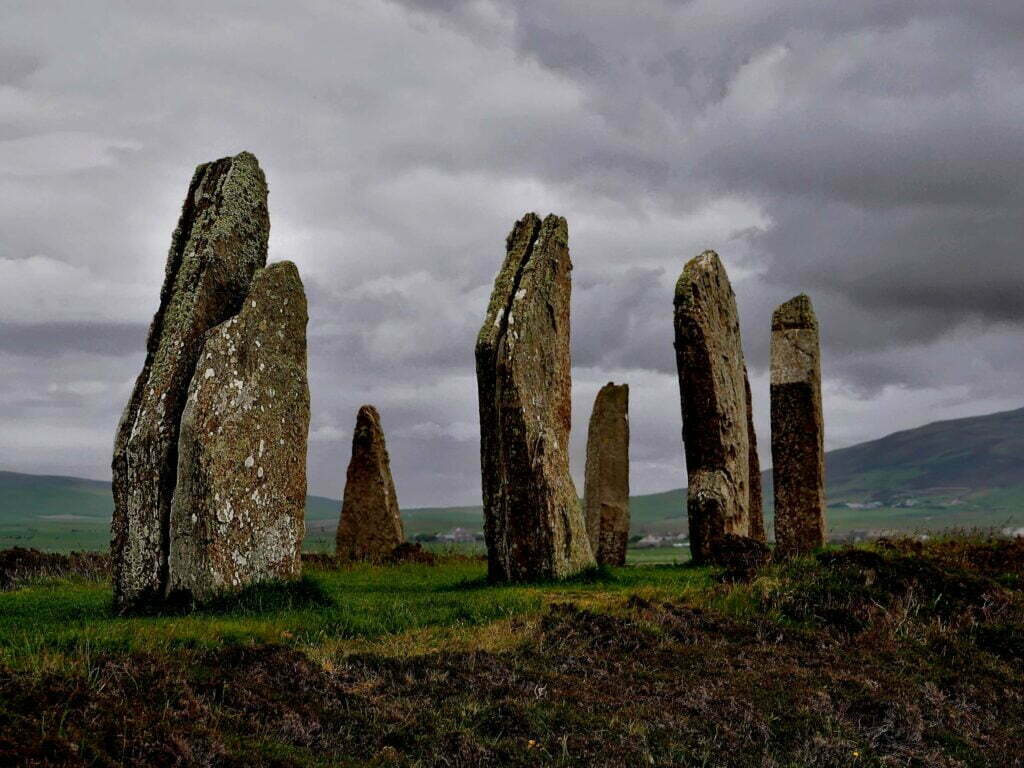The Heart of Neolithic Orkney is a UNESCO World Heritage Site located in the Orkney Islands, an archipelago off the north coast of Scotland in the United Kingdom. This World Heritage Site encompasses a group of outstanding prehistoric monuments and archaeological sites that provide insights into the lives and practices of ancient peoples. The heart of Neolithic Orkney includes the following sites:
Heart of Neolithic Orkney
1. Skara Brae: Skara Brae is a remarkably well-preserved Neolithic village that dates back over 5,000 years. It consists of a series of stone-built houses connected by covered passageways. The village offers a unique glimpse into the daily lives, architecture, and technologies of Neolithic inhabitants.
2. Maeshowe: Maeshowe is a Neolithic chambered tomb known for its well-preserved Viking graffiti. The tomb’s interior features a central chamber with side cells and a long entrance passage. It’s believed to have served as a tomb, a ceremonial site, and possibly an astronomical observatory.
3. Ring of Brodgar: The Ring of Brodgar is a stone circle and henge monument consisting of 27 standing stones arranged in a near-perfect circle. It’s thought to have had ceremonial, ritual, and possibly astronomical significance.
4. Standing Stones of Stenness: This site features a collection of standing stones, including the tallest remaining standing stone in Scotland. The stones are arranged in a rectangular pattern and are believed to have held ritualistic and ceremonial importance.
5. Ness of Brodgar: This archaeological site is a recent discovery and is still being excavated. It contains a complex of Neolithic structures, including a large stone building with elaborate stonework. The site is shedding new light on the complexity of Neolithic society and construction techniques.
These sites collectively showcase the advanced architectural and engineering skills of Neolithic peoples and provide a window into their beliefs, rituals, and way of life. The Heart of Neolithic Orkney is a testament to the exceptional cultural heritage of the region and its significance in understanding the history of human civilization.
Visitors to the Heart of Neolithic Orkney can explore these sites, learn about their historical and archaeological importance, and appreciate the stunning landscapes of the Orkney Islands. It’s a destination that offers a unique opportunity to connect with ancient history and experience the beauty of the Scottish Islands.
Things to do near Heart of Neolithic Orkney Islands
The Heart of the Neolithic Orkney Islands offers a range of activities and attractions beyond its historic sites. Here are some things to do and places to explore in and around this UNESCO World Heritage Site:
6. Visit the Sites: Of course, the main attractions are the Neolithic sites themselves. Take your time to explore Skara Brae, Maeshowe, the Ring of Brodgar, the Standing Stones of Stenness, and the ongoing excavations at the Ness of Brodgar.
7. Orkney Museum: Located in Kirkwall, the Orkney Museum provides insights into the history and culture of the Orkney Islands, from prehistoric times to the present day. It’s a great place to learn more about the context of the Neolithic sites.
8. Kirkwall: Explore the charming town of Kirkwall, the capital of Orkney. Visit St. Magnus Cathedral, a stunning medieval cathedral, and wander through the historic streets and waterfront.
9. Birsay: This village on the northwest coast of the Orkney Mainland is home to the Birsay Bay Tearoom, where you can enjoy a meal with a beautiful view. The nearby Birsay Bay is also a great place for birdwatching.
10. Italian Chapel: While not within the Neolithic sites area, the Italian Chapel is a remarkable attraction on the island of Lamb Holm. It was constructed by Italian prisoners of war during World War II and is a testament to human creativity and resourcefulness.
11. Coastal Walks: Take advantage of the stunning coastal landscapes of the Orkney Islands by going for walks along the shores. Enjoy the fresh air, dramatic cliffs, and sea views.
12. Island Hopping: Consider taking a ferry to some of the smaller islands around Orkney. These islands often offer unique landscapes, wildlife, and historical sites.
13. Orkney Crafts: Explore local craft shops and galleries to discover Orkney-made jewelry, ceramics, textiles, and other handmade items.
14. Archaeological Tours: Some local guides offer specialized archaeological tours that delve deeper into the history and significance of the Neolithic sites.
15. Wildlife Watching: Orkney is home to a variety of wildlife, including seabirds, seals, and even whales in the surrounding waters. Look out for opportunities to spot these creatures.
16. Cultural Festivals: Depending on the time of year, you might have the chance to participate in local festivals, events, and gatherings that celebrate Orkney’s culture and heritage.
17. Cafes and Restaurants: Enjoy traditional Orkney cuisine and fresh seafood in local cafes and restaurants. Don’t miss the chance to try some locally caught seafood.
Exploring the heart of Neolithic Orkney offers a unique blend of history, culture, and natural beauty. Make sure to plan your visit according to the opening hours of the sites and consider the weather conditions, as the islands can be quite exposed to the elements.
Getting to the Heart of Neolithic Orkney, Scotland, from London
Getting to the heart of Neolithic Orkney from London involves a combination of transportation methods, including trains, ferries, and possibly buses. The Orkney Islands are located off the north coast of Scotland, and the journey can take some time due to the distance involved. Here’s a general guide on how to make the journey:
18. Train from London to Edinburgh: Start by taking a train from London to Edinburgh, which is the capital of Scotland. The journey takes around 4–5 hours, depending on the type of service you choose.
19. Train or bus from Edinburgh to Thurso or Scrabster: From Edinburgh, take a train or bus to Thurso or Scrabster. These are the northernmost towns on the Scottish mainland, and they are close to where the ferry to Orkney departs. The train journey takes about 4-5 hours, and the bus journey may take longer.
20. Ferry to Orkney: From Thurso, you can take a ferry to Orkney. The ferry route from Scrabster to Stromness on Orkney is a common option. The ferry ride takes around 90 minutes to 2 hours, depending on the weather and the specific ferry service.
21. Local Transport on Orkney: Once you arrive on Orkney, you’ll need to use local transport, such as buses or taxis, to reach the Heart of Neolithic Orkney sites. Public transport is available on the Orkney Mainland, where most of the historic sites are located.
22. Flights: Alternatively, you can consider taking a flight from Edinburgh or Glasgow to Kirkwall, the largest town on Orkney. Kirkwall has an airport with flights operated by various airlines. The flight takes around an hour.
Please note that travel times and schedules may vary, so it’s essential to check current schedules, availability, and any travel advisories before planning your trip. The journey to Orkney involves several connections and modes of transport, so be prepared for a longer journey compared to traveling within the mainland UK. It’s also a good idea to book your train tickets, ferry tickets, and accommodations well in advance, especially during peak travel seasons.

